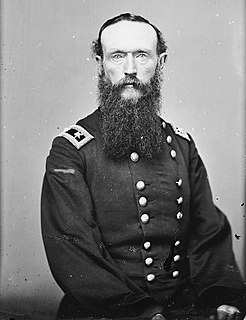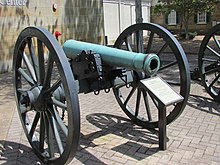
The Battle of Arkansas Post, also known as Battle of Fort Hindman, was fought from January 9 to 11, 1863, near the mouth of the Arkansas River at Arkansas Post, Arkansas, as part of the Vicksburg Campaign of the American Civil War. Confederate forces had constructed a fort known as Fort Hindman near Arkansas Post in late 1862. In December of that year, a Union force under the command of Major-General William T. Sherman left for an expedition against Vicksburg, without Major-General John A. McClernand because neither Major-Generals Henry Halleck nor Ulysses S. Grant trusted McClernand. After Sherman's force was repulsed at Chickasaw Bayou, McClernand arrived and took command from Sherman in January 1863.

The Battle of Marais des Cygnes took place on October 25, 1864, in Linn County, Kansas, during Price's Missouri Raid in the American Civil War. It is also known as the Battle of Trading Post. In late 1864, Confederate Major General Sterling Price invaded the state of Missouri with a cavalry force, attempting to draw Union troops away from the primary theaters of fighting further east. After several victories early in the campaign, Price's Confederate troops were defeated at the Battle of Westport on October 23 near Kansas City, Missouri. The Confederates then withdrew into Kansas, camping along the banks of the Marais des Cygnes River on the night of October 24. Union cavalry pursuers under Brigadier General John B. Sanborn skirmished with Price's rearguard that night, but disengaged without participating in heavy combat.

The First Battle of Newtonia was fought on September 30, 1862, between Confederate soldiers commanded by Colonel Douglas H. Cooper and a Union column commanded by Brigadier General Frederick Salomon near Newtonia, Missouri, during the American Civil War. Cooper's force had moved into southwestern Missouri, and encamped near the town of Newtonia. The Confederate column was composed mostly of cavalry led by Colonel Joseph O. Shelby and a brigade of Native Americans. A Union force commanded by Brigadier General James G. Blunt moved to intercept Cooper's force. Blunt's advance force, led by Salomon, reached the vicinity of Newtonia on September 29, and attacked Cooper's position on September 30. A Union probing force commanded by Colonel Edward Lynde was driven out of Newtonia by Cooper's forces on the morning of the 30th.

The Battle of St. Charles was fought on June 17, 1862, at St. Charles, Arkansas, during the American Civil War. Earlier in 1862, a Union Army force commanded by Major General Samuel R. Curtis moved against Little Rock, Arkansas, but became bogged down in the Batesville area due to lack of supplies. The Union leadership decided to send a naval force from Memphis, Tennessee, up the White River to resupply Curtis's men. Major General Thomas C. Hindman, the Confederate commander in Arkansas, had fortifications constructed near St. Charles to stop the Union movement. Two artillery positions were built, and three ships, including CSS Maurepas, were scuttled to obstruct the river.
The Battle of Bayou Meto, also known as the Battle of Reed's Bridge, was fought near present-day Jacksonville, Arkansas, along the Bayou Meto River, on August 27, 1863. During the American Civil War, Union forces left Helena, Arkansas, to move against the Confederate-held state capital of Little Rock. Part of the Union command, under Brigadier General John W. Davidson, defeated Confederate cavalry commanded by Brigadier General John S. Marmaduke on August 25, in the Battle of Brownsville. After the action at Brownsville, the Confederates fell back to the Bayou Meto. Union attacks on August 27 succeeded in pushing Marmaduke's men back across the bayou, but were unable to break the Confederate line. Davidson withdrew back to Brownsville after the fighting. The Union advance resumed on September 6, and Little Rock surrendered on September 10, after the Battle of Bayou Fourche. Tensions exacaberated during the action at Bayou Meto contributed to the Marmaduke-Walker duel, during which a Confederate general was killed. In 2002, part of the battlefield was listed on the National Register of Historic Places as the Bayou Meto Battlefield.
The Battle of Van Buren was fought at Van Buren, Arkansas on December 28, 1862, during the American Civil War. After defeating Confederate forces led by Major General Thomas C. Hindman at the Battle of Prairie Grove on December 7, 1862, Union forces under Brigadier Generals James G. Blunt and Francis J. Herron prepared for a raid against the Confederate positions at Van Buren and Fort Smith. Disease, lack of supplies, and desertion had forced Hindman to previously begin withdrawing most of his force from the area. Setting out on December 27, the Union troops struck at an outlying Confederate cavalry unit near Drippings Spring, north of Van Buren, on the morning of December 28. The Confederate cavalry fled to Van Buren, which was then overrun by Union troops.

The Battle of Bayou Fourche saw Union forces under the overall command of Frederick Steele clash with Confederate forces led by Sterling Price near Little Rock, Arkansas. The only fighting occurred when Steele's cavalry commanded by John W. Davidson crossed to the south side of the Arkansas River and compelled the Confederate cavalry under John S. Marmaduke to abandon its defensive position behind Bayou Fourche. Price's outnumbered forces evacuated Little Rock and withdrew south to Arkadelphia. The Union occupation of Little Rock was the final action in a campaign that started on August 18 when Steele's troops marched west from DeValls Bluff.
The 3rd Missouri Cavalry Regiment was a cavalry regiment of the Confederate States Army during the American Civil War. It was also known as Greene's Regiment after its commander, Colonel Colton Greene.

Landis's Missouri Battery, also known as Landis's Company, Missouri Light Artillery, was an artillery battery that served in the Confederate States Army during the early stages of the American Civil War. The battery was formed when Captain John C. Landis recruited men from the Missouri State Guard in late 1861 and early 1862. The battery fielded two 12-pounder Napoleon field guns and two 24-pounder howitzers for much of its existence, and had a highest reported numerical strength of 62 men. After initially serving in the Trans-Mississippi Theater, where it may have fought in the Battle of Pea Ridge, the unit was transferred east of the Mississippi River. The battery saw limited action in 1862 at the Battle of Iuka and at the Second Battle of Corinth.
The 3rd Missouri Light Battery was an artillery battery of the Confederate States Army during the American Civil War. The battery originated as a Missouri State Guard unit active in late 1861, and was officially transferred to the Confederate States Army on January 28, 1862. The battery provided artillery support at the Battle of Pea Ridge in March 1862, and was lightly engaged at the Battle of Iuka in September. In October 1862, the battery was lightly engaged at the Second Battle of Corinth and saw action at the Battle of Davis Bridge, where it lost at least one cannon. The 3rd Light Battery saw action at the Battle of Champion Hill on May 16, 1863, and had its cannons captured at the Battle of Big Black River Bridge the next day. After participating in the Siege of Vicksburg, the battery was captured on July 4, 1863 and was paroled and exchanged. The battery was then consolidated with the Jackson Missouri Battery; the 3rd Light Battery designation was continued. In early 1864, the battery received replacement cannons and was assigned to the defense of Mobile Bay. The 3rd Light Battery saw action at the Battle of Spanish Fort in March and April 1865. When the Confederate Department of Alabama, Mississippi, and East Louisiana surrendered on May 4, 1865, the battery was again captured; the men of the battery were paroled on May 10, ending their military service.
Harris's Missouri Battery was an artillery battery that served in the Confederate States Army during the American Civil War. The battery was organized in early 1864 when the 13th Missouri Light Battery was reorganized in a process that may not have been officially approved; Captain Samuel Stanhope Harris commanded the new unit. The battery fought in the Camden Expedition in early 1864, seeing action in the Battle of Prairie D'Ane and the Battle of Poison Spring in April. In June, the battery was present at the Battle of Ditch Bayou. Harris's Battery accompanied Sterling Price during his raid into Missouri in late 1864, during which it fought at the battles of Pilot Knob, Glasgow, Little Blue River, Big Blue River, and Mine Creek, as well as several smaller skirmishes. At Mine Creek, the battery's cannons were captured. On May 26, 1865, the battery surrendered; the men of the battery were paroled.

Battery E, 1st Missouri Light Artillery Regiment was an artillery battery unit from Missouri that served in the Union Army during the American Civil War. The 1st Missouri Light Artillery Regiment formed on 1 September 1861. The battery participated in Frémont's expedition to Springfield in October 1861. This was followed by actions at Prairie Grove and Van Buren in December 1862. The following year, the battery fought at Cape Girardeau, Chalk Bluff, Vicksburg, the Expedition to Morganza, Brownsville, and Fort Esperanza. After performing garrison duty at Brownsville, Texas, the unit was mustered out in June 1864. For a few months at the end of 1864, a Pennsylvania battery took the name of this unit.
The 9th Missouri Infantry Regiment was an infantry regiment that served in the Confederate States Army during the American Civil War. The unit was formed on November 16, 1862, and was originally commanded by Colonel John Bullock Clark Jr. At the Battle of Prairie Grove on December 7, 1862, the regiment was officially in Brigadier General John S. Roane's brigade, although it served with Brigadier General Mosby M. Parsons' brigade for most of the battle. After spending the summer of 1863 harassing Union Navy shipping on the Mississippi River, the regiment was reorganized, with elements of an Arkansas unit being replaced with the 8th Missouri Infantry Battalion. After the reorganization, the regiment fought in the Battle of Pleasant Hill and the Battle of Jenkins' Ferry in April 1864. On June 7, 1865, the men of the regiment were paroled; they would eventually be sent back to Missouri via steamboat.
Slayback's Missouri Cavalry Regiment was a cavalry regiment of the Confederate States Army during the American Civil War. Originally formed as Slayback's Missouri Cavalry Battalion, the unit consisted of men recruited in Missouri by Lieutenant Colonel Alonzo W. Slayback during Price's Raid in 1864. The battalion's first action was at the Battle of Pilot Knob on September 27; it later participated in actions at Sedalia, Lexington, and the Little Blue River. In October, the unit was used to find an alternate river crossing during the Battle of the Big Blue River. Later that month, Slayback's unit saw action at the battles of Westport, Marmiton River, and Second Newtonia. The battalion was briefly furloughed in Arkansas before rejoining Major General Sterling Price in Texas in December. Probably around February 1865, the battalion reached official regimental strength after more recruits joined.
Hiram Bledsoe's Missouri Battery was an artillery battery that served in the Missouri State Guard and the Confederate States Army during the American Civil War. The battery was formed when the Missouri State Guard was formed as a pro-secession state militia unit in response to the Camp Jackson affair. As part of the Missouri State Guard, the unit was engaged in the Engagement near Carthage and the Battle of Wilson's Creek during mid-1861, before fighting at the Battle of Dry Wood Creek and the Siege of Lexington later that year when Major General Sterling Price led the Guard northwards towards the Missouri River. After the Missouri State Guard retreated into Arkansas in early 1862, Bledsoe's Battery served during the Confederate defeat at the Battle of Pea Ridge in March. The battery, as part of the Army of the West, transferred across the Mississippi River into Tennessee in April, where it left the Guard to enter Confederate service on April 21.

The 8th Missouri Infantry Regiment was an infantry regiment that served in the Confederate States Army during the American Civil War. The American Civil War began in April 1861 with the Battle of Fort Sumter, and fighting soon escalated. Beginning in May, events in the state of Missouri led to an expansion of the war into that state. In 1862, Confederate recruiting activities took place in Missouri, and a cavalry regiment was formed in Oregon County. On September 2, the unit entered Confederate service, but was soon reclassified as infantry. After many of the unit's men transferred to other units, the regiment was reclassified as a battalion and named the 7th Missouri Infantry Battalion. Under the name Mitchell's Missouri Infantry, the unit was part of a Confederate offensive at the Battle of Prairie Grove on December 7. During the battle, the unit made several charges against the Union lines, but was repeatedly repulsed by artillery fire. The regiment spent most of early 1863 encamped near Little Rock and Pine Bluff in Arkansas, and may have been part of an expedition to the Mississippi River.
Nichols's Missouri Cavalry Regiment served in the Confederate States Army during the late stages of the American Civil War. The cavalry regiment began recruiting in early 1864 under Colonel Sidney D. Jackman, who had previously raised a unit that later became the 16th Missouri Infantry Regiment. The regiment officially formed on June 22 and operated against the Memphis and Little Rock Railroad through August. After joining Major General Sterling Price's command, the unit participated in Price's Raid, an attempt to create a popular uprising against Union control of Missouri and draw Union troops away from more important theaters of the war. During the raid, while under the command of Lieutenant Colonel Charles H. Nichols, the regiment was part of an unsuccessful pursuit of Union troops who were retreating after the Battle of Fort Davidson in late September.
The 13th Missouri Cavalry Regiment was a cavalry unit that served in the Confederate States Army during the American Civil War. In early April 1863, Captain Robert C. Wood, aide-de-camp to Confederate Major General Sterling Price, was detached to form an artillery unit from some of the men of Price's escort. Wood continued recruiting for the unit, which was armed with four Williams guns, and grew to 275 men by the end of September. The next month, the unit fought in the Battle of Pine Bluff, driving back Union Army troops into a barricaded defensive position, from which the Union soldiers could not be dislodged. By November, the unit, which was known as Wood's Missouri Cavalry Battalion, had grown to 400 men but no longer had the Williams guns. In April 1864, Wood's battalion, which was also known as the 14th Missouri Cavalry Battalion, played a minor role in the defeat of a Union foraging party in the Battle of Poison Spring, before spending the summer of 1864 at Princeton, Arkansas. In September, the unit joined Price's Raid into the state of Missouri, but their assault during the Battle of Pilot Knob failed to capture Fort Davidson.
Barrett's Missouri Battery was an artillery battery that served in the Confederate States Army during the American Civil War. After entering Confederate service on April 1, 1862, the unit was armed with two 6-pounder smoothboore cannons and two 12-pounder howitzers and was commanded by Captain Overton W. Barrett. It was present during the Siege of Corinth, but saw no action. During the Battle of Perryville in October 1862, Barrett's battery provided artillery support for a Confederate brigade. After spending the next several months moving around Tennessee, the battery supported a Confederate attack during the Battle of Stones River in December. The 1863 Chickamauga campaign brought light action for the unit, which also fought in the Battle of Missionary Ridge. When the Confederates retreated after the Missionary Ridge fighting, Barrett's battery was part of the Confederate rear guard at the Battle of Ringgold Gap, earning the praise of Patrick R. Cleburne. Rearmed with four 12-pounder howitzers, the unit was action in the 1864 Atlanta campaign as part of the Confederate reserve artillery, although two of the cannons were lost to attrition. On April 16, 1865, the battery ceased to exist when its flag, cannons, and most of its members were captured during the Battle of Columbus, Georgia. As of January 2021, its battle flag is part of the collection of the Missouri State Museum.
The 10th Texas Field Battery was an artillery battery that served in the Confederate States Army during the American Civil War. After being formed in early 1861 by Benjamin H. Pratt, the battery served with a cavalry formation led by Colonel William Henry Parsons for part of 1862. It was called upon to enter Missouri in support of troop movements related to the Battle of Prairie Grove, but this did not occur. It then operated along the Mississippi River in early 1863, harassing enemy shipping. The unit then participated in Marmaduke's Second Expedition into Missouri and the Battle of Pine Bluff in 1863. Late in 1864, the battery, now under the command of H. C. Hynson, served in Price's Raid, participating in several battles and skirmishes, including the disastrous Battle of Mine Creek. One source claims the unit's service ended on May 26, 1865, while a Confederate report dated June 1, 1865, states that it existed but did not have cannons. Confederate forces in the Trans-Mississippi Department surrendered on June 2.












